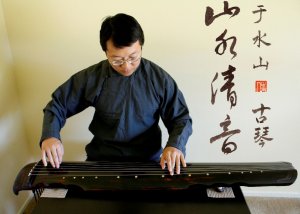Presented By: Confucius Institute at the University of Michigan
Qin Music: The Embodiment of Literati Culture of East Asia
A Lecture-Demonstration

This lecture introduces the music and culture of qin, an ancient
Chinese instrument with a millennia-long history. With a technical emphasis on the various ways to touch, stop, and strike the strings, qin music explores the richness in timbre as no other instrument does. Through a unique system of notation, education, performance, and
appreciation, the qin tradition encourages personal interpretation in the re-creation of music and brings down the division between
composer and player, thus opening the door for the creation of
various regional and stylistic schools. Qin shares common aesthetic and spiritual ideals with other traditional cultural forms such as
poetry, calligraphy, and painting. The philosophy behind qin music and the physical and conceptual environment for the appreciation of the sound and silence are closely connected with the literati art and
culture of East Asia.
Shuishan Yu is a fourth generation Mei’an School qin player,
Professor of Art History at Oakland University, and Chair of North America Mei’an Guqin Society. He has inherited much of the styles and masterpieces from the traditional repertoire, and added many unique personal interpretations. Yu teaches qin at Oakland and performs widely in China and the US. He is developing a new system in qin
education by creating a series of fingering-specific studies, and
composing new qin music based on classical Chinese literature.
Masterpieces of qin music will be performed during the lecture,
including:
关山月 Moon over the mountain pass
é…’ç‹‚ Drunken madness
平沙è½é›ï¼Œä¹å¶·æ´¾ Wild geese descending on the beach, Jiuyi School
平沙è½é›ï¼Œæ¢…庵派 Wild geese descending on the beach, Mei’an School
æµæ°´ Flowing water
Chinese instrument with a millennia-long history. With a technical emphasis on the various ways to touch, stop, and strike the strings, qin music explores the richness in timbre as no other instrument does. Through a unique system of notation, education, performance, and
appreciation, the qin tradition encourages personal interpretation in the re-creation of music and brings down the division between
composer and player, thus opening the door for the creation of
various regional and stylistic schools. Qin shares common aesthetic and spiritual ideals with other traditional cultural forms such as
poetry, calligraphy, and painting. The philosophy behind qin music and the physical and conceptual environment for the appreciation of the sound and silence are closely connected with the literati art and
culture of East Asia.
Shuishan Yu is a fourth generation Mei’an School qin player,
Professor of Art History at Oakland University, and Chair of North America Mei’an Guqin Society. He has inherited much of the styles and masterpieces from the traditional repertoire, and added many unique personal interpretations. Yu teaches qin at Oakland and performs widely in China and the US. He is developing a new system in qin
education by creating a series of fingering-specific studies, and
composing new qin music based on classical Chinese literature.
Masterpieces of qin music will be performed during the lecture,
including:
关山月 Moon over the mountain pass
é…’ç‹‚ Drunken madness
平沙è½é›ï¼Œä¹å¶·æ´¾ Wild geese descending on the beach, Jiuyi School
平沙è½é›ï¼Œæ¢…庵派 Wild geese descending on the beach, Mei’an School
æµæ°´ Flowing water